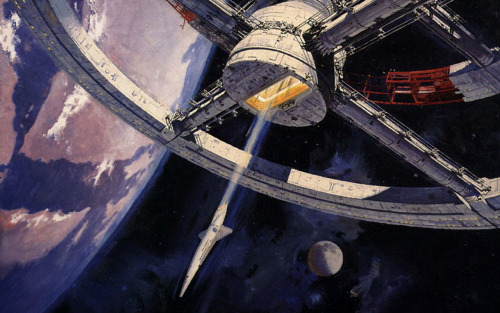
This is what it was supposed to be.
... we would have massive orbital stations where people lived and worked. Space travel would be commonplace, at least in a limited sense. We would be colonising Earth's orbit and the Moon, for sure, and we would be using these places as the stepping stone for greater human exploration of our solar system and beyond.
...
What did we get? A floating lab and a bunch of satellites so we could pay Rupert Murdoch money to watch football and have a bossy woman in a box order us around in our cars.
We have fallen far short of our potential. But hey, at least a few rich guys got richer.
A floating lab/assembly point is the critical first step and part of the station pictured above would be a floating lab and assembly point.
The Direct-to-Home data market (Television) has by far the largest Revenue of any space venture - $72.22 Billion. I will come back to this in a moment.

As for the "bossy woman in a box" - the Global Positioning System (GPS) is incredibly integrated into all of our lives and paid for by only US taxpayers. The cost of your terminal is solely the cost of the terminal and profit that TomTom, Garmin, etc make. Automatic Teller Machines, digital gas pumps (the ones that take your credit card), power substations, and various other high-precision timing applications utilize the GPS constellation for timing. When initially established the US military had a means to turn GPS off. The international economic ramifications of such an act now make this impossible.
So, what happened? Why haven't we colonized Earth orbit and put an outpost or two on Mars and had a manned mission to orbit Jupiter?
The digital computing revolution happened. The technological means by which we are currently communicating makes the need to have humans on-orbit, on the Moon, or anywhere else more difficult to "sell."
The Apple II had more computing power than the Apollo spacecraft that took men to the Moon. We went from having fairly simple analog computer systems in the late 1960s to having microcontrollers and microprocessors in the 1970s.
But in the late 1960s the discussion of man vs machine/electronics was already being waged. The USAF
Manned Orbiting Laboratory was a USAF program to put a manned observation post in orbit. This would allow for high-resolution imagery to be taken from orbit, analyzed by the on-station personnel, who would then report via radio or some other low-bandwidth medium what they saw in the photos. As a comparison the systems in use would take pictures on film over a period of time and return those to the Earth via a re-entry capsule. These re-entry capsules had to be caught upon re-entry or recovered from the ocean floor. The manned system would provide more rapid analysis of the images and allow for more timely action.

But in parallel, unmanned systems were being advanced and digital photography was being developed. It was the only way to get pictures of Mars, Jupiter, etc on the probes. It also enabled the intelligence community to develop spacecraft that did not need a man-in-the-loop in order to gather timely intelligence. Eventually this technology found its way into consumers hands - digital cameras.

All the above is a short way of saying the same electronics whose development was advanced by space exploration and applications resulted in a reduced need for human beings in space.

And back to the Direct-to-Home television satellites on orbit. These companies are in the business of making money and they would rather offer their consumers (at a higher price point) an astronomical number of channels (most of which are never watched) at a cosmic resolution and refresh rate (something most people will not even notice). This means more satellites, preferably staying on-orbit longer.

A big limiter to a satellites useful life is how much fuel it has on-board. Even the first series of perturbations in Earth orbit require a measure of orbital maintenance and thus the expenditure of fuel. In addition, sometimes components fail and reduce the spacecrafts capability, but it is a single unit or two. Lastly, orbital debris threatens the continuing operations of these spacecraft in a very real way. A single bolt on a crossing orbit could destroy the spacecraft's ability to transmit the football game (whether it is an American in Dallas watching ManU in Manchester or a Britain in Manchester watching the Cowboys in Dallas) and threaten other spacecraft.

Automated spacecraft fueling is already being pursued, but it is the next two were I think we begin to see the opportunity for direct human presence in Earth orbit in order to make money from the space environment. In order to protect their assets, these companies may pay good money.
Whatever the task is, it must be a very complex task where telecommunications lag could result in mission failure. 
If we develop FTL communications prior to a significant human presence beyond the Earth, we may
never grow beyond it.

And that is the real struggle - what product does an orbiting city provide to the Earth? Answering that simple question makes the future
so close, but so far away happen. The technology exist and has for decades, it is a lack of will and/or need.

 Author
Topic: End of the NASA Space Shuttle (Read 7671 times)
Author
Topic: End of the NASA Space Shuttle (Read 7671 times)

